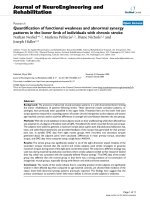3 7 patterns in the sky (earth sciences)
Bạn đang xem bản rút gọn của tài liệu. Xem và tải ngay bản đầy đủ của tài liệu tại đây (4.28 MB, 10 trang )
Earth Sciences
Standards
Preview
4.b. Students know the way in which
the Moon’s appearance changes
during the four-week lunar cycle.
Standard Set 4. Earth Sciences
4. Objects in the sky move in regular
and predictable patterns. As a basis
for understanding this concept:
4.e. Students know the position of
the Sun in the sky changes during the
course of the day and from season to
season.
4.a. Students know the patterns of
stars stay the same, although they
appear to move across the sky nightly,
and different stars can be seen in
different seasons.
by Arlene Block
Genre
Nonfiction
Comprehension Skill
Follow Instructions
Text Features
•
•
•
•
Captions
Diagrams
Charts
Glossary
Science Content
Sun, Moon, and
Earth’s Seasons
Scott Foresman Science 3.7
ISBN 0-328-23536-9
ì<(sk$m)=cdfdga< +^-Ä-U-Ä-U
Vocabulary
axis
constellation
phases of the Moon
revolution
rotation
by Arlene Block
Picture Credits
Every effort has been made to secure permission and provide appropriate credit for photographic material. The
publisher deeply regrets any omission and pledges to correct errors called to its attention in subsequent editions.
Unless otherwise acknowledged, all photographs are the copyright of Dorling Kindersley, a division of Pearson.
14 Royal Greenwich Observatory/©DK Images; 15 Royal Greenwich Observatory/©DK Images
ISBN: 0-328-23536-9
Copyright © Pearson Education, Inc. All Rights Reserved. Printed in the United States of America.
This publication is protected by Copyright, and permission should be obtained from the publisher prior to any
prohibited reproduction, storage in a retrieval system, or transmission in any form by any means, electronic,
mechanical, photocopying, recording, or likewise. For information regarding permission(s), write to
Permissions Department, Scott Foresman, 1900 East Lake Avenue, Glenview, Illinois 60025.
1 2 3 4 5 6 7 8 9 10 V010 13 12 11 10 09 08 07 06
What are some
patterns that repeat
every day?
The Spinning Earth
You don’t feel Earth move. But it is always
Day and Night
Earth spins on its axis. It makes one
complete spin, or rotation, every 24 hours.
This causes day and night. As Earth rotates,
half of Earth always faces the Sun. That side
has day. The side not facing the Sun has night.
This pattern repeats every day.
From Earth, it looks like the Sun is moving
moving. Look at this picture of Earth. Find the line
across the sky. But really, it is Earth that is
drawn through the center. It is not a real line. It is
moving!
an imaginary line called an axis. Earth spins on
this imaginary line.
Suppose you could look down on Earth from
As Earth rotates, this part
of Earth is just starting to
face the Sun.
space. You would see Earth spinning. Think of the
direction the hands on a clock move. Earth turns in
the opposite direction from this.
Earth spins
around its axis.
2
3
Shadow Patterns
A shadow forms when sunlight hits an object.
Shadows also change direction during the day.
They point away from the Sun. In the morning,
The size of a shadow changes during the day.
the Sun is in the east. Then shadows stretch west.
That is because the Sun’s position in the sky
After midday, shadows stretch east. You can keep
seems to change.
track of where the Sun is. Shadows get longer near
Shadows become shorter as the Sun appears to
sunset.
move higher in the sky. At noon, the Sun appears
West
East
West
East
West
East
to be overhead. Shadows are very short. The Sun
seems to continue moving across the sky. Shadows
get longer toward sunset.
Morning
The Sun appears to rise
in the east.
Midday
The Sun appears to
move across the sky.
The Sun appears to set
in the west.
4
Afternoon
5
What patterns
repeat every year?
Earth’s Tilt
Earth rotates on its axis. At the same time, Earth
moves around the Sun. It takes about one year to
make a complete trip. Earth’s trip around the Sun
is called a revolution.
Look at Earth’s axis in each picture.
Do you see how it’s tilted? Earth’s
axis always tilts in the same
direction.
As Earth moves, different places are tilted
toward the Sun. In some places on Earth’s path
around the Sun, the northern half of Earth is tilted
toward the Sun. This half is called the Northern
Hemisphere. During other times, the southern half
of Earth is tilted toward the Sun. The part tilted
toward the Sun gets the most direct sunlight. These
places are warmed the most. The part of Earth that
is tilted away from the Sun gets the least direct
sunlight. These places are warmed the least.
March The northern half of
Earth is getting warmer, but the
southern half is getting cooler.
December It is winter
in the northern half of
Earth, but summer in the
southern half.
June It is summer
in the northern half of
Earth and winter in the
southern half.
6
September The northern
half of Earth is getting
cooler, but the southern half
is getting warmer.
7
When the Sun appears
higher in the sky, there
are more hours of
daylight.
Seasons
The amount of sunlight changes in patterns.
Changes in temperature also form patterns.
These patterns are called seasons. You live in the
Northern Hemisphere. There, summer usually has
the warmest temperatures. Winter has the coolest
temperatures.
June
West
East
The Northern Hemisphere is tilted away from
the Sun in winter. It gets less direct sunlight. It has
more hours of darkness than hours of daylight.
This pattern changes in spring and fall. Earth’s axis
does not tilt toward or away from the Sun. There is
about the same amount of daylight as darkness.
The picture shows
the effects of Earth’s
tilted axis on the Sun’s
position and hours of
daylight.
The way the Sun
appears to cross
the sky changes
with the seasons.
The Sun’s Position in the Sky
The Sun appears to follow a path across the sky.
The Sun appears in different places along this path
December
East
West
in different seasons. This is because of Earth’s tilted
axis. During summer in the Northern Hemisphere,
the Sun looks like it is nearly overhead. In winter,
the Sun looks lower in the sky.
8
9
What are Moon
and star patterns?
The Moon and the Sun
Have you watched the Moon? What does it look
like? It looks different at different times. Sometimes
Like Earth, the Moon rotates on its axis. The
Moon revolves around Earth. One half of the Moon
is almost always in sunlight. We see different
amounts of this half. That’s why the Moon seems
to change shape. The changes are called the
phases of the Moon. These pictures show the
Moon’s phases. The phases repeat in a pattern.
you can’t see it at all! At other times you can see
it in the daytime. These changes are caused by
sunlight and the motions of the Moon and Earth.
Phases of the Moon
The Moon moves around Earth
in a path. As it moves, the
same side of the Moon always
faces Earth.
First
Quarter
Waxing
Moon
Full
Moon
Waning
Moon
Third
Quarter
Crescent
Moon
10
11
Star Patterns
Go outside on a clear night. Look at the Little
What do you see when you look at the sky on
Dipper and the Big Dipper. Look at them again a
a dark, clear night? You may see thousands of
few hours later. You may think they moved. They
twinkling stars. Some of the brighter stars seem
look that way because Earth rotates on its axis.
to be in groups. They make patterns or shapes.
Find the Little Dipper in each picture. Do you
A group of stars that makes a pattern is called
see the star at the end of the “handle”? This is
a constellation.
the North Star. It is over the North Pole. In the
Northern Hemisphere, all the other stars seem to
These pictures show patterns that look like
rotate around the North Star.
cups with handles. The patterns are called the
Little Dipper and the Big Dipper. They are parts of
constellations.
The Dippers
three hours
later
The Dippers early
at night in the
summer
North Star
The Dippers
six hours
later
North
Star
North Star
12
13
Star Positions in Different Seasons
Look at the sky on a clear summer night. You
Different Stars in Different Seasons
The stars in Cassiopeia change position. But you
can see a group of stars that looks like the letter
can see them all year. Some stars can only be seen
W. They are part of the constellation Cassiopeia.
at one time of the year. Even though we can’t see
On a winter night, you cannot see Cassiopeia in
them, they are still in the daytime sky.
the same place. Why? As Earth revolves around
the Sun, we face slightly different parts of space.
By winter, Earth has moved to the other side of
A Winter Sky Star Pattern
These stars are part of the constellation Orion,
the Sun. You see the night sky from a different
the Hunter. You can see them in the sky on a clear
direction.
winter night. The position of Orion changes over
In summer in the
Northern Hemisphere,
Cassiopeia is low in
the sky.
several months. You cannot see Orion in summer.
In winter in the
Northern Hemisphere,
Cassiopeia is almost
overhead.
North
Star
North
Star
14
15
What did you learn?
Glossary
axis
constellation
the imaginary line around
which the Earth spins
a group of stars that make
a fixed pattern
phases of the Moon set of each of the different
ways that the Moon looks
revolution
one complete trip an
object takes around
another object
rotation
one complete spin on
an axis
16
1. How long does it take Earth to make a full rotation on
its axis?
2. Does the Sun really move across the sky? Explain your
answer.
3. How does what you see in the night sky change with
the seasons?
4.
You learned about the
phases of the Moon. Suppose you look at the sky at the
same time every night for a month. Write a paragraph
that describes what you will see.
5.
Follow Instructions Write steps for drawing a
diagram of Earth revolving around the Sun as it rotates
on its axis.









